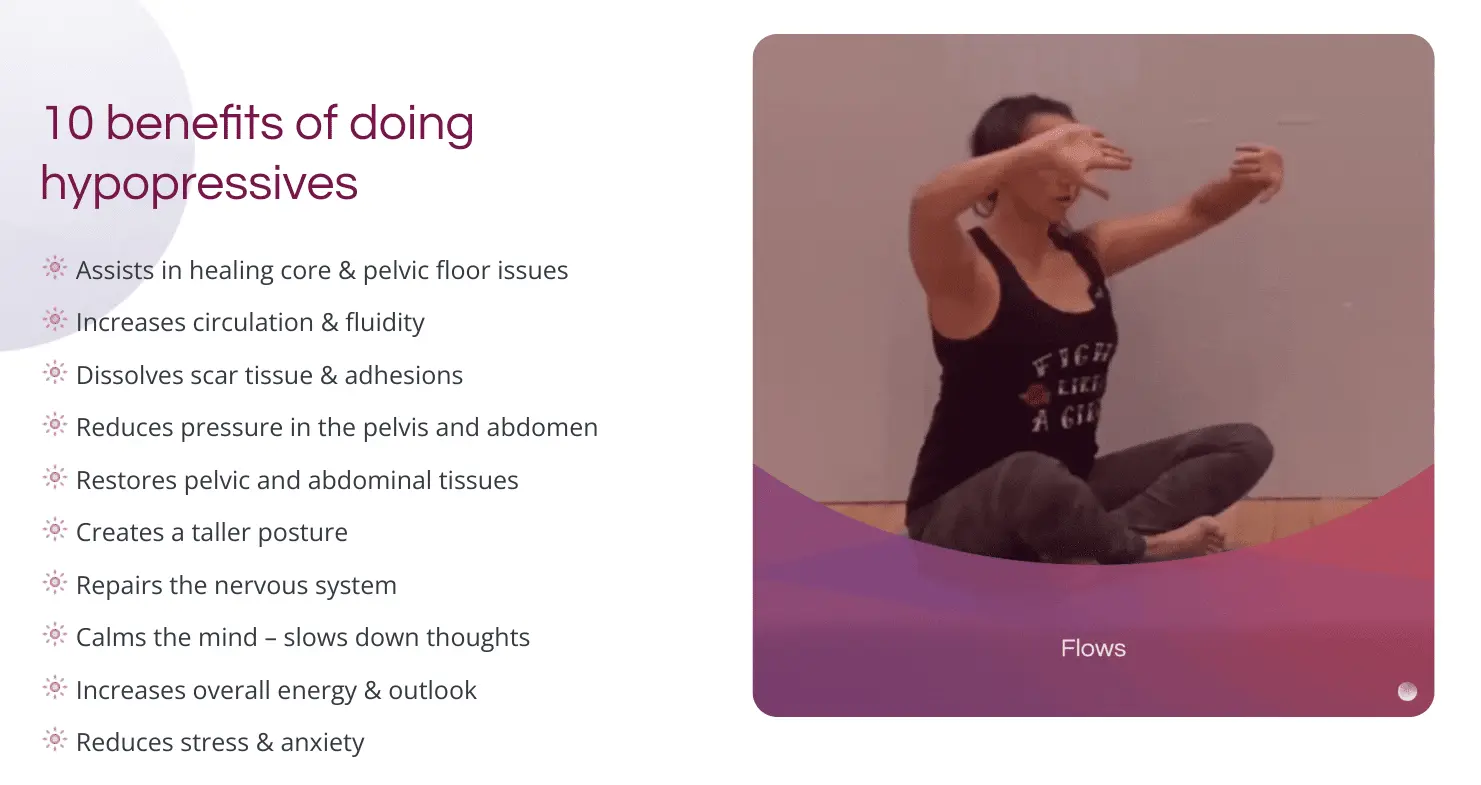Hypopressives for Prolapse, Incontinence & Diastasis-Recti
- June 9, 2022
- Diastasis RectiPelvic Floor

Pelvic floor disorders like prolapse, incontinence, and diastasis recti are extremely common. In fact, about one in four women experiences at least one.
Women are even made to believe that they are normal and a part of becoming a mother or growing older. Many feel ashamed of talking about these issues and choose to silently suffer instead.
If you are one of them, we have great news for you. While common, pelvic floor disorders aren’t normal and they also aren’t permanent. It is possible to heal pelvic organ prolapse, incontinence, and diastasis recti with regular practice of exercises such as hypopressives and relaxation. To heal naturally, most likely you also need to do some lifestyle changes and use other holistic methods.
Read more about how you can heal too.
Let’s take a closer look at the most common incontinence, diastasis recti, and pelvic organ prolapse causes, why hypopressives are an effective solution, and how you can take your first steps toward feeling better and more empowered. Because regardless of what you may have heard before, who said we can’t heal? And, most importantly, who said we can’t heal naturally?
What’s the Most Common Cause of Pelvic Organ Prolapse, Incontinence, and Diastasis Recti?
The most common causes of pelvic organ prolapse, incontinence, and diastasis recti are pregnancy, labor, and childbirth, especially if these happen with complications. That’s due to increased abdominal pressure.
To understand how that happens, we need to understand biotensegrity. Imagine holding a balloon between your hands and squeezing it. The areas below your hands will move closer to each other whereas other areas will pop out. Your abdominal cavity works in a very similar way. When pressure is being applied, it hits the weakest areas the hardest.
So, when the abdominal pressure increases dramatically, such as during pregnancy and childbirth, it can weaken or even injure pelvic floor muscles and tissues.
As a result, the person is no longer able to properly relax or coordinate these muscles to control urine and bowel movements.
Moreover, pelvic organs such as the uterus, bladder, and bowels can be pulled into the vaginal cavity resulting in prolapse.
The different types of Pelvic Organ Prolapse (POP)
Pregnancy and childbirth are the most common causes of pelvic organ prolapse and incontinence. However, they can also occur due to an injury such as after a car accident, excess weight, advanced age, menopause, and other factors.
In the case of diastasis recti, there is increased pressure on the connective tissues that hold the two sides of the abdominal muscles together. If the abdominal muscles are weak or improperly engaged, it causes them to bulge and the body can get used to this alignment. Due to that, a woman may still look pregnant long after having given birth.
Our body makes a lot of space for our babies, and some of our abdomens stay in the same state post-birth.
How to Control Bladder Leakage
and Heal Pelvic Organ Prolapse
with Physical Exercise?
Urinary incontinence can not only be unpleasant but also embarrassing. Some women may only experience it when doing high-impact exercises like jumping or running. Others have a hard time holding their pee when coughing, sneezing, or laughing and require frequent bathroom trips.
If you’ve been looking into how to control or fix bladder leakage and heal prolapse, you likely have come across suggestions to strengthen the pelvic floor with Kegels. On the surface it makes sense. If your pelvic floor muscles are weak, it would only seem logical that you would need to strengthen them.
Kegels aren’t the answer
In reality, Kegels are ineffective, and it’s not what you should do to stop urine leakage. If you suffer from incontinence and pelvic organ prolapse, in the best-case scenario, exercises like Kegels won’t provide any help or release. In the worst-case scenario, they can make matters worse.
Kegels can push pelvic organs further out into the vagina, making prolapse more severe. Moreover, focusing solely on strengthening the pelvic muscles can lead to a tight, overactive, and imbalanced pelvic floor that is unable to relax. This imbalance can also aggravate pelvic floor dysfunction. According to medical experts, a tight or hypertonic pelvic floor is very common. Yet, it’s also extremely underlooked which leads to many cases not being addressed.
So, if not Kegels, how can you control bladder leakage and heal pelvic organ prolapse?
Hypopressives is an effective method that can not only provide immediate relief after a single session but also long-term benefits.
Keep in mind that physical exercise is just one piece of the puzzle. Women who would like to heal bladder leakage and prolapse can greatly benefit from a holistic approach and integrating other natural healing methods. These include adjusting their diet habits, incorporating scar tissue treatment, and working with emotions.
Can you Heal Diastasis Recti With Hypopressives?
Traditional exercises, especially if incorrectly performed, create internal pressure that presses against already weakened connective tissues. So, even if the abdominal muscles become stronger in the process, the shape in which they stay in a relaxed state bulges outward, creating the look of a bigger and wider tummy and weakening the core.
So, instead of engaging in a strenuous exercise routine to build strength, it’s best to focus on retraining these muscles with gentle exercise routines such as hypopressives. This trains the abdominal muscles to hug in just like a corset instead of bulging out. This makes separation less noticeable and the tummy flatter and stronger.
As with incontinence and prolapse, it is important to adopt a holistic approach to heal diastasis recti naturally. Diet and work with emotions and scar tissue are some of the additional approaches that you can also benefit from.
What Are Hypopressives?
Hypopressives or the Hypopressive method is a series of breathing and postural exercises. They improve pelvic floor health as well as core functionality. While hypopressives are great for everyone, they are especially beneficial for women who suffer from pelvic floor dysfunction and diastasis recti following childbirth.
Below are a few ways in which you can benefit from regular hypopressive work:
• having a stronger and more balanced pelvic floor,
• thinner waist – hypopressives train the deep core muscles to engage property and “hug in” as well as tones the visible abdominal muscles, leading to reduced abdominal fat and thinner and more compact appearance,
• reduced diastasis recti without adding additional strain on the connective tissues – deep core muscles learn how to engage properly, provide greater support, and pull the two halves of the abdominal muscles together,
• healing or preventing incontinence – since pelvic floor muscles become more balanced, they are able to contract and relax optimally, and when necessary,
• healing or preventing pelvic organ prolapse without placing additional strain on the pelvic floor – the pelvic floor gains the strength necessary to provide adequate support for the pelvic organs,
• reduced menstrual pain and discomfort,
• reduced back pain – since the pelvic area, abdominals, and back muscles all form the core, increased strength and control in the pelvic and abdominal area reduce the strain on the back,
• improved posture,
• faster postpartum recovery,
• better digestion,
• positive impact on mental health, such as reduced anxiety and depression symptoms and higher self-esteem.
Hypopressive routines are short and functional and, as a result, easy to fit into a busy daily life. You also do not need any equipment to perform them.
Why Are Hypopressives Beneficial
for Prolapse, Incontinence,
and Diastasis Recti?
Most of the activities we perform on the daily basis and traditional exercises such as sit-ups are hyper-pressive. They increase the internal pressure in our bodies and continue pressing on the weak areas. As a result, pelvic floor dysfunction and diastasis recti can worsen even more.
The core is designed to work at a subconscious level, so it can be effective throughout daily life, not just when you are exercising. It needs to kick into action if you have to suddenly run for a bus, or swoop in to pick up your child when they fall over. It needs to work without you thinking about it.
Hypopressive exercises decrease or reduce internal pressure, to the thoracic, abdominal, and pelvic areas of the body. They reprogram the core muscles, which are vital to managing pressure both consciously and subconsciously, and they increase their resting tone and involuntary function.
In other words, the core, including the pelvic floor, starts to work again as it was designed to – without you having to think about it.
Hypopressives are easy to learn if you have the right teacher, but they are also easy to get wrong. So, it’s really important that you seek out a qualified instructor to teach you.
Hypopressive Pelvic Floor Exercise
Would you like to give hypopressives a try and experience how they feel? Then, join us for the foundation of hypopressives – lateral breath. All you’ll need is a mat.
Keep in mind that these instructions are purely informational. You should not perform them while pregnant, within six weeks after vaginal birth and ten weeks following a C-section, after recent abdominal or heart surgery, or if you suffer from hypertension, heart or pulmonary disease, IUDs, IBS or Crohn’s flare-up.
Simple Hypopressive Breathing Exercise
• Lay down on your back with your knees bent. Place your feet on the mat with your feet parallel and hip-distance apart. Make sure that your knees are pointing directly up and aren’t swaying to the sides or inwards.
• Relax your body and place your hands on the sides of your ribcage. You can also hold your arms up, bend the elbows to the sides, and keep your hands in front of your face with palms facing away from you.
• Take a deep inhale through your nose and feel your abdomen and ribcage expand.
• Open your mouth and exhale through the mouth until there is no more air left. You’ll notice that your core muscles will sink and move toward your spine as you exhale. Once you feel that there is no more air left, hold your breath for ten seconds.
• Slowly inhale through the nose once more and repeat the cycle. Always make sure that you inhale through the nose and complete the exhale through the mouth.
Congratulations, you’ve just taken your first hypopressive breaths and given your pelvic floor some well-deserved rest and relaxation. How did it feel?
Here is a 10-minute guided lateral
breathing exercise from
my Youtube channel:
MoonRise Can Help You Continue
Your Hypopressive Journey
from Home
As with any exercise routine, it is critical to practice with caution and under the guidance of a skilled professional. This can help avoid complications and achieve better results.
If you would like to learn more about Hypopressives and use the method to reverse symptoms of pelvic organ prolapse, incontinence, and diastasis recti, join our Free Webinar too learn how to get started with Hypopressives from home.
On this call, you’ll also learn about our Hypopressive Exercise Course that can help improve your pelvic floor health, starting with just 10 to 15 minutes a day.
If you have questions, contact us by email.
Blog posts you might like:






